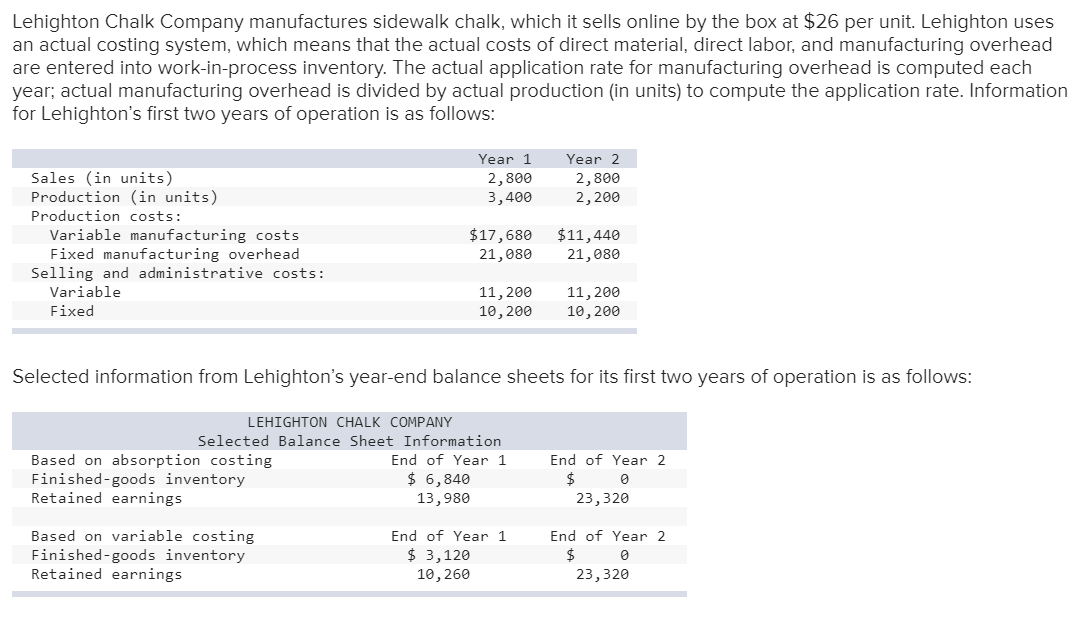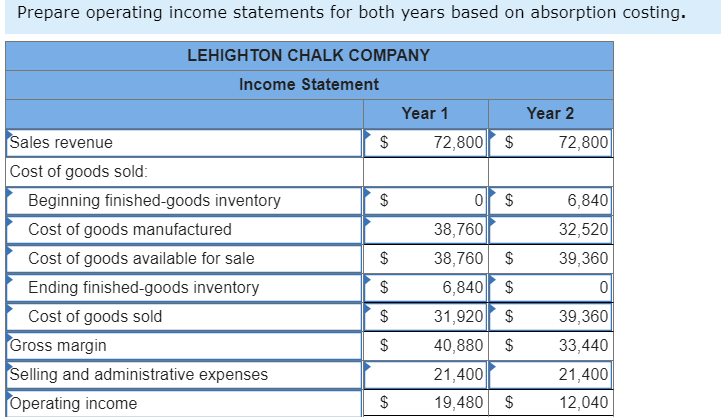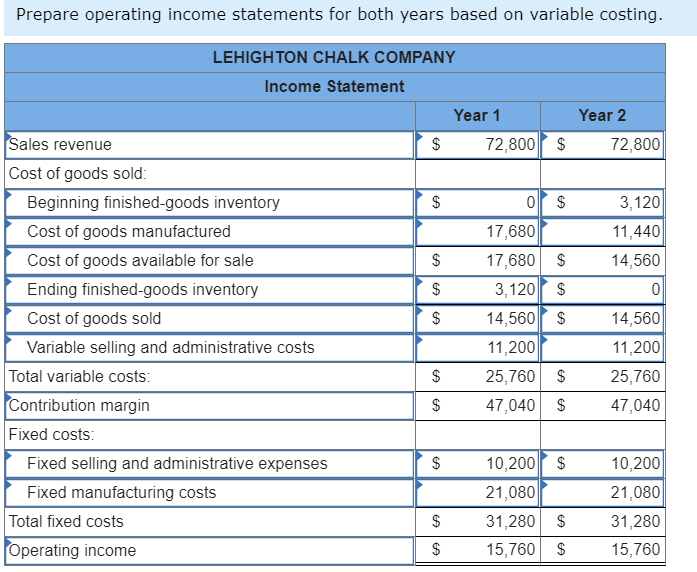



Lehighton Chalk Company manufactures sidewalk chalk, which it sells online by the box at $26 per unit. Lehighton uses an actual costing system, which means that the actual costs of direct material, direct labor, and manufacturing overhead are entered into work-in-process inventory. The actual application rate for manufacturing overhead is computed each year; actual manufacturing overhead is divided by actual production (in units) to compute the application rate. Information for Lehighton's first two years of operation is as follows: Year 1 2,800 3,400 Year 2 2,800 2,200 Sales (in units) Production (in units) Production costs: Variable manufacturing costs Fixed manufacturing overhead Selling and administrative costs: Variable Fixed $17,680 21,080 $11,440 21,080 11,200 10,200 10,200 Selected information from Lehighton's year-end balance sheets for its first two years of operation is as follows: LEHIGHTON CHALK COMPANY Selected Balance Sheet Information Based on absorption costing End of Year 1 Finished-goods inventory $ 6,840 Retained earnings 13,980 End of Year 2 23,320 End of Year 2 Based on variable costing Finished-goods inventory Retained earnings End of Year 1 $ 3,120 10,260 23,320 Required: 4. Compute the amount by which the year-end balance in finished-goods inventory declined during year 2 (i.e., between December 31 of year 1 and December 31 of year 2): Using the data from the balance sheet prepared under absorption costing. Using the data from the balance sheet prepared under variable costing. 5. Refer to your calculations from requirement 4. Compute the difference in the amount by which the year-end balances in finished- goods inventory declined under absorption versus variable costing. Then compare the amount of this difference with the difference in the company's reported operating income for year 2 under absorption versus variable costing. Prepare operating income statements for both years based on absorption costing. Year 2 72,800 $ $ LEHIGHTON CHALK COMPANY Income Statement Year 1 Sales revenue $ 72,800 Cost of goods sold: Beginning finished-goods inventory 0 Cost of goods manufactured 38,760 Cost of goods available for sale $ 38,760 Ending finished-goods inventory $ 6,840 Cost of goods sold $ 31,920 Gross margin $ 40,880 Selling and administrative expenses 21,400 Operating income $ 19,480 6,840 32,520 39,360 $ $ $ $ 39,360 33,440 21,400 12,040 $ Prepare operating income statements for both years based on variable costing. Year 2 72,800 3,120 11,440 14,560 LEHIGHTON CHALK COMPANY Income Statement Year 1 Sales revenue $ 72,800 $ Cost of goods sold: Beginning finished-goods inventory $ 0 $ Cost of goods manufactured 17,680 Cost of goods available for sale $ 17,680 $ Ending finished-goods inventory $ 3,120 $ Cost of goods sold $ 14,560 $ Variable selling and administrative costs 11.200|| Total variable costs: $ 25,760 $ Contribution margin $ 47,040 $ Fixed costs: Fixed selling and administrative expenses $ 10,200 $ Fixed manufacturing costs 21,080 Total fixed costs $ 31,280 $ Operating income $ 15,760 $ 14,560 11,200 25,760 47,040 10,200 21,080 31,280 15,760 Lehighton Chalk Company manufactures sidewalk chalk, which it sells online by the box at $26 per unit. Lehighton uses an actual costing system, which means that the actual costs of direct material, direct labor, and manufacturing overhead are entered into work-in-process inventory. The actual application rate for manufacturing overhead is computed each year; actual manufacturing overhead is divided by actual production (in units) to compute the application rate. Information for Lehighton's first two years of operation is as follows: Year 1 2,800 3,400 Year 2 2,800 2,200 Sales (in units) Production (in units) Production costs: Variable manufacturing costs Fixed manufacturing overhead Selling and administrative costs: Variable Fixed $17,680 21,080 $11,440 21,080 11,200 10,200 10,200 Selected information from Lehighton's year-end balance sheets for its first two years of operation is as follows: LEHIGHTON CHALK COMPANY Selected Balance Sheet Information Based on absorption costing End of Year 1 Finished-goods inventory $ 6,840 Retained earnings 13,980 End of Year 2 23,320 End of Year 2 Based on variable costing Finished-goods inventory Retained earnings End of Year 1 $ 3,120 10,260 23,320 Required: 4. Compute the amount by which the year-end balance in finished-goods inventory declined during year 2 (i.e., between December 31 of year 1 and December 31 of year 2): Using the data from the balance sheet prepared under absorption costing. Using the data from the balance sheet prepared under variable costing. 5. Refer to your calculations from requirement 4. Compute the difference in the amount by which the year-end balances in finished- goods inventory declined under absorption versus variable costing. Then compare the amount of this difference with the difference in the company's reported operating income for year 2 under absorption versus variable costing. Prepare operating income statements for both years based on absorption costing. Year 2 72,800 $ $ LEHIGHTON CHALK COMPANY Income Statement Year 1 Sales revenue $ 72,800 Cost of goods sold: Beginning finished-goods inventory 0 Cost of goods manufactured 38,760 Cost of goods available for sale $ 38,760 Ending finished-goods inventory $ 6,840 Cost of goods sold $ 31,920 Gross margin $ 40,880 Selling and administrative expenses 21,400 Operating income $ 19,480 6,840 32,520 39,360 $ $ $ $ 39,360 33,440 21,400 12,040 $ Prepare operating income statements for both years based on variable costing. Year 2 72,800 3,120 11,440 14,560 LEHIGHTON CHALK COMPANY Income Statement Year 1 Sales revenue $ 72,800 $ Cost of goods sold: Beginning finished-goods inventory $ 0 $ Cost of goods manufactured 17,680 Cost of goods available for sale $ 17,680 $ Ending finished-goods inventory $ 3,120 $ Cost of goods sold $ 14,560 $ Variable selling and administrative costs 11.200|| Total variable costs: $ 25,760 $ Contribution margin $ 47,040 $ Fixed costs: Fixed selling and administrative expenses $ 10,200 $ Fixed manufacturing costs 21,080 Total fixed costs $ 31,280 $ Operating income $ 15,760 $ 14,560 11,200 25,760 47,040 10,200 21,080 31,280 15,760










